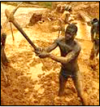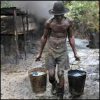Difference between revisions of "DATE Africa - Criminal Activity"
Hunt.james (talk | contribs) m (→Commodity Theft and Smuggling) |
|||
| (3 intermediate revisions by one other user not shown) | |||
| Line 1: | Line 1: | ||
| + | |||
| + | <div style="font-size:0.9em; color:#333;" id="mw-breadcrumbs"> | ||
| + | [[Africa|DATE Africa]] > '''{{PAGENAME}}''' ←You are here | ||
| + | </div> | ||
| + | |||
| + | |||
The often unstable economic and security situations across the continent have allowed criminal activity and corruption to flourish. Elsewhere in the world, corrupting and co-opting of government officials by criminal enterprises is usually to gain operating freedom. In the OE, such activities are competitive enablers, intended to gain access to internal and external markets. How these large-scale domestic criminal enterprises and international criminal manifest within the OE are characteristic of each country's circumstances and history. | The often unstable economic and security situations across the continent have allowed criminal activity and corruption to flourish. Elsewhere in the world, corrupting and co-opting of government officials by criminal enterprises is usually to gain operating freedom. In the OE, such activities are competitive enablers, intended to gain access to internal and external markets. How these large-scale domestic criminal enterprises and international criminal manifest within the OE are characteristic of each country's circumstances and history. | ||
| Line 17: | Line 23: | ||
The <u>sex trade</u> is one of the key drivers of human trafficking in the OE. The victims are usually between 8 and 15-years of age. Some will be transported out of the OE to be sold as sex-slaves, while others are made to work within the OE in the sex-tourism industry. They are often acquired by kidnapping from outlying farms or small towns and may be members of vulnerable communities, such as the homeless, refugees, drug users, or urban trans-sexuals. They may also be stolen during interdicted migration or tourist movement. There have been a number of public markets reported where humans were available for purchase. | The <u>sex trade</u> is one of the key drivers of human trafficking in the OE. The victims are usually between 8 and 15-years of age. Some will be transported out of the OE to be sold as sex-slaves, while others are made to work within the OE in the sex-tourism industry. They are often acquired by kidnapping from outlying farms or small towns and may be members of vulnerable communities, such as the homeless, refugees, drug users, or urban trans-sexuals. They may also be stolen during interdicted migration or tourist movement. There have been a number of public markets reported where humans were available for purchase. | ||
| − | The other main purpose of trafficked persons within the OE is <u>forced labor</u> as soldiers, illicit mining, or other dangerous occupations. These victims will usually be 10 to 25 years old and male. The primary acquisition method is by raids on mines, camps, or private prisons. Some may initially volunteer, seeking wealth or out of desire for purpose. ''See also "[[Army of Justice and | + | The other main purpose of trafficked persons within the OE is <u>forced labor</u> as soldiers, illicit mining, or other dangerous occupations. These victims will usually be 10 to 25 years old and male. The primary acquisition method is by raids on mines, camps, or private prisons. Some may initially volunteer, seeking wealth or out of desire for purpose. ''See also "[[Army of Justice and Purity#AJP use of Child Soldiers|AJP use of Child Soldiers]]".'' |
==Commodity Theft and Smuggling== | ==Commodity Theft and Smuggling== | ||
| Line 47: | Line 53: | ||
''See also: [[Chapter 5: Noncombatants|TC 7-100.3 Irregular Opposing Forces, Chapter 5: Noncombatants]]'' | ''See also: [[Chapter 5: Noncombatants|TC 7-100.3 Irregular Opposing Forces, Chapter 5: Noncombatants]]'' | ||
| + | |||
| + | [[Category:DATE]] | ||
| + | [[Category:Africa]] | ||
| + | [[Category:Crime]] | ||
Latest revision as of 18:18, 4 January 2019
The often unstable economic and security situations across the continent have allowed criminal activity and corruption to flourish. Elsewhere in the world, corrupting and co-opting of government officials by criminal enterprises is usually to gain operating freedom. In the OE, such activities are competitive enablers, intended to gain access to internal and external markets. How these large-scale domestic criminal enterprises and international criminal manifest within the OE are characteristic of each country's circumstances and history.
Criminal enterprises may have a pronounced impact on military operations in the OE. Dominant criminal elements may view external military forces as a threat to their territorial control, while less-powerful organizations may look to exploit shifts in security and rules of engagement to gain access to markets or power.
See also TC 7-100.3 Irregular Opposing Forces, Chapter 4: Criminals
Contents
Drug Trafficking
Heroin and cocaine are the main drugs for trafficking through the REGION OE. These drugs generally enter the OE via established lines of communication from Asia and Central/South America, are processed and packaged, then smuggled out of the OE to European and other lucrative markets. Heroin and cocaine have little domestic distribution. Several cartels dominate heroin and cocaine trafficking in the OE, including the powerful Hodari Cartel (heroin) and Donya Syndicate (cocaine). Limited, tense cooperation or truces among organizations may exist to minimize public/political backlash and reduce unnecessary violence.There are numerous smaller groups that specialize in other drugs, such as cannabis, methaqualone, and khat. These groups often operate growth or production facilities in proximity to an urban area or transit hub in areas with ineffective law enforcement. While these groups also export a substantial amount of their drugs to foreign markets, a large proportion is intended for domestic distribution.
All of these groups are highly territorial and have a history of being quick to violence. In addition to their primary drug, they will also be involved in ancillary criminal activities, such as protection, racketeering, prostitution, and commodity smuggling. Groups often operate with local political, community, or military awareness and possibly involvement. Operations are usually enabled by corrupt border or customs enforcement officials. Security at production and shipment facilities is paramount. In addition to their robust security forces, larger drug organizations may hire legitimate private security companies or partner with other irregular forces to secure their operations. Rural operations may have a guerrilla or militia-style forces to protect the organization's interests.
Human Trafficking
The practice of the theft, smuggling, and trafficking in persons has been an ongoing problem to the OE. International organizations and NGOs have fought to reduce the problem, but the power and money in the practice make it a lucrative trade for a variety of criminal and irregular actors in the OE.The sex trade is one of the key drivers of human trafficking in the OE. The victims are usually between 8 and 15-years of age. Some will be transported out of the OE to be sold as sex-slaves, while others are made to work within the OE in the sex-tourism industry. They are often acquired by kidnapping from outlying farms or small towns and may be members of vulnerable communities, such as the homeless, refugees, drug users, or urban trans-sexuals. They may also be stolen during interdicted migration or tourist movement. There have been a number of public markets reported where humans were available for purchase.
The other main purpose of trafficked persons within the OE is forced labor as soldiers, illicit mining, or other dangerous occupations. These victims will usually be 10 to 25 years old and male. The primary acquisition method is by raids on mines, camps, or private prisons. Some may initially volunteer, seeking wealth or out of desire for purpose. See also "AJP use of Child Soldiers".
Commodity Theft and Smuggling
Another outgrowth of the complex economic and political environment across the OE is illicit movement of finished goods and bulk commodities. Primary commodities include sugar, electronics, counterfeit goods, cigarettes, timber, stolen cars, minerals, and precious stones. Observable activities are often at/near port facilities and production locations. Bulk goods are often illicitly moved through large ports with assistance from corrupt officials to avoid customs fees. Corrupt officials may allow or facilitate these activities with falsified inspections and other documents. Linkage with known extremists (Hizbul al-Harakat and Army of Justice and Purity) is likely.
Illicit mining
Illicit mining occurs when a group seizes control of an abandoned commercial mining site. The sites may be perceived by their former owners as tapped-out or too dangerous to continue operations. Mined materials include gold, gems, and high value minerals. These operations are usually located in remote areas with ineffective law enforcement. Due to the volatile, protective nature of these operations and related illicit labor acquisition, violence and gang battles are a nightly occurrence, making transit through the areas extremely dangerous. Local government officials and possibly military elements may allow the sites to operate in exchange for favors.
Oil theft, processing, and smuggling
A similar practice is oil theft, processing, and smuggling. These operations have several components and operate in areas where there is a large commercial operation and ineffective law enforcement. The first step is the theft by tapping or other means of a commercial pipeline. The product is then smuggled, usually by small independent operators, to a remote improvised refinery. From there, it may be smuggled offshore to waiting ships or in smaller quantities for consumer distribution. These operations have a variety of economic and political impacts. The local economy may depend on illicit supply, with networks of sellers throughout the local economy. Government policing and maritime patrolling will likely have difficulty finding or stopping these operations. Competition for these resources is high and territorial defenses may be brutal. Illicit operations may affiliate with guerrilla or militia groups.
Protection Economies
The longstanding practice of providing access to areas or resources is an outgrowth of the complex social realities rampant within the REGION OE, incl. poor governance and law enforcement. These activities may be conducted my local irregular forces or even corrupt government officials and military/paramilitary elements. While essentially criminal, those involved may have strong local acceptance, as they are often more nimble and effective than the government capabilities. Rather than being an impediment, many view these practices as a basic cost of doing business that streamlines governance and allows access to global markets.These criminal protection practices may leverage private security organization to portray legitimacy and professionalism. Corrupt politicians or military elements may use criminal or other irregular forces for effectiveness and deniability. External forces or NGOs in the OE may risk attacks or losses if not cooperative. Protection groups may give discounts to gain other objectives or curry favor.
Criminal Gangs
Street crime is common in most places of the world, but the power, organization, and integration with other irregular elements is of special importance to Forces operating in the REGION OE. Large numbers of displaced or marginalized young men, combined with volatile economic conditions and inconsistent law enforcement have led to these dangerous groupings. Many members join for self-protection or to have a sense of purpose, but many see it as one of the few avenues to financial security and status.
Criminal gangs in the OE are generally observable as small groups or gatherings of more than 100 and are most often localized to their stated territories. They will be armed with a mix of small arms, improvised blades and incendiaries. They may also quickly employ improvised obstacles such as burning tires, debris, and cars. Their somewhat limited armed capabilities are greatly enhanced with ubiquitous mobile communications and in-depth knowledge of their territories. They have high situational awareness of forces and activities in and around their areas of control. Their sophisticated use of social media to conduct precision attacks and avoid detection.
Gangs may be hired or motivated to assist other irregular groups. Insurgent groups have reportedly contracted gangs to infiltrate peaceful demonstrations to agitate and destabilize the crowd. Guerrilla groups and militias regularly use these gangs to conduct low-level strikes and kidnapping for forces labor.
See also: TC 7-100.3 Irregular Opposing Forces, Chapter 4: Criminals-Gangs
Agitated Civilian Groups
Large groups of civilians may assemble for planned or spontaneous demonstrations or protest. The factors influencing a crowd's agitation and potential violent actions are diverse and complex. There will usually be one or more motivating incidents leading to the gathering that is likely organized via social media. These assemblies are generally only loosely organized, but can rapidly coalesce and escalate tensions. Otherwise peaceful demonstrations may be driven to act as a mob or even pushed into riot. Large groups of civilians may be hired or leveraged by criminals or insurgents to create distractions, dynamic obstacles, or INFOWAR opportunities.
See also: TC 7-100.3 Irregular Opposing Forces, Chapter 5: Noncombatants





